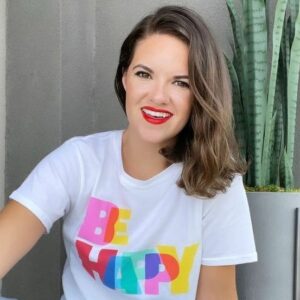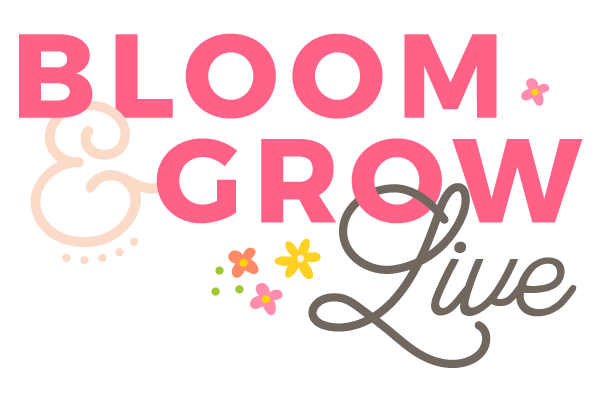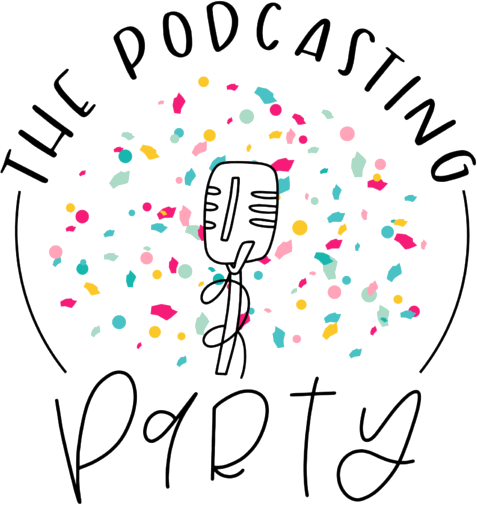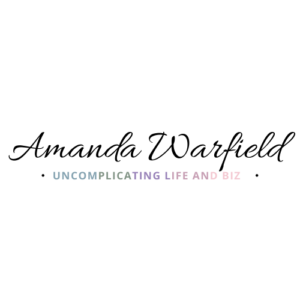

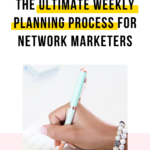
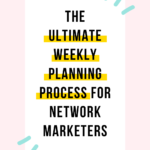
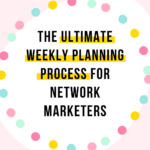

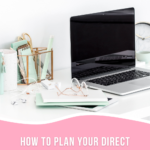



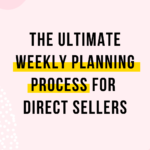
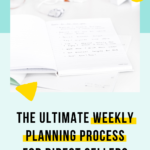

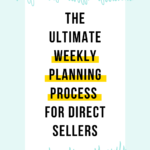




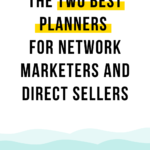



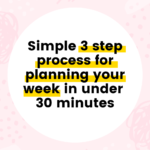


The truth is, planning can feel hard or overwhelming if you don't know where to start, have too much to keep track of, or don’t have a structured process. Today I’m giving you a sneak peek inside my weekly planning process so that you can reach your goals faster, feel more in control, and use your time more intentionally, too.
Whether you already have a process in place but feel like there's something missing, or you've been searching for a process that you'll actually be able to follow through on (I know how hard that can be!) my hope is that seeing the behind-the-scenes of what has given me peace and structure will help bring you the same.
Listen now!
Prefer to read, blog post style?
Episode Transcript
024. How to Plan Your Entire Week in 30 minutes
0:00
Okay, I'm super, super excited about this episode. And I'm gonna try really hard not to go off on a lot of tangents. But this is something I'm very passionate about, very excited about. And it's something that I struggled with for a really, really long time, which I know a lot of people who listen to this podcast, also struggled just like I did. And so I'm, I'm just so thrilled to be able to talk about this and share my experience, how I've gone about doing things, so that hopefully, you can pick out some little
0:34
gems that will help you in your life. And what am I talking about? I'm talking about planning your week, planning your workweek, this could be planning your regular life week, this could be planning your nine to five, it could be planning your business, but planning in general.
0:53
For years,
0:54
I avoided planning, I had this weird like, and I still do, I totally still have this. But I had this weird, like, little rebellious streak in me that I was like, No, I don't want to be told what to do. I want to be able to be flexible, do my own thing. Isn't that why I started my business, right like to just do whatever I want. But the truth is, is that when you live that, you know, quote, unquote, fly by the seat of your pants life, like I was doing, you get a lot less done, and it becomes a lot harder to hit the goals that you're setting, because there's no plan to get there. There's no steps to get there. And if you do eventually get there, it probably is going to take you twice as long. And I will talk about that a little bit in this episode. But I'm really excited all at all to be able to talk about this with you. So hopefully, you'll be able to take some gems from this. If you do if you enjoy this episode, would you mind taking a second on iTunes or audible or Spotify? If you're listening on any of those platforms? Would you mind leaving a review and just sharing what you took away from this episode or why you enjoy the podcast, having those reviews is so incredibly helpful. And honestly, it just really makes my day when I see a new review pop up, because it just means the world that I can actually use this platform to help other people. So while you're listening, we'll go ahead and get into get into it now. But while you're listening, if you could take a second lever review, I would seriously be so grateful. Okay, let's dig into this. So planning. I think that when they're when it comes to planning, there's really two kinds of people and this is going to be polarizing. Like, I totally understand that, you know, the world can't just be divided into 50% and 50%. There's always going to be outliers and in betweens and all of that, but like let's oversimplify for the purpose of this episode. I think there's really two kinds of people when it comes to planning. There are the people who love it can't live without it. They are like, their planner is there right or die like they can't get through the day without their planner. But then on the flip side, there are the people who totally need a plan, but they just don't do it. And this was me. So if you're hearing me say that and you're like feeling a little bit called out, don't stress because I'm calling myself out here is the people who need a plan, but they just don't do it. Maybe you're overwhelmed. There's a lot going on in your life. You're like, how do I even get this organized? Where do I start? Maybe you don't want to give up freedom. Like I was just talking about this feeling of I don't want to be, you know, stuck in this plan of I have to get this done. I can't stray I can't do anything else feeling like you're sort of trapped in the schedule, right? totally understand that feeling cuz I'm, I'm that person, very much me. That kind of like rebellious feeling. Or maybe you're someone who struggles to get into routines, and this is something again, this is very much me. So if you're someone who struggles to get into routines, maybe you know no matter how many days in a row, you do something if you forget one day, it's like instantly gone, right? You just can't get back into it. Or
4:15
you have all
4:16
the best intentions of doing something every day. And then for some reason, you just you always forget and maybe at the end of the day, you're like Oh man, I was supposed to do that new thing whether it was drinking a glass of water every hour or I don't know brushing your hair a certain number of times before bed that's kind of an old thing that they used to say back in like the 90s but you get what I'm saying right? Like you might struggle to get into routines or do something on repeat every day. And I was totally that person. I was honestly all three of those people.
4:47
I'm
4:49
in the past. I tried a lot of different planners and a lot of different ideas for planning different methods of planning. You know, you can do all this stuff. Following super in depth routines and all this stuff, and I just always consistently struggled, so between the people who love it and can't live without a plan, and then the people who need to plan
5:13
but don't do it, I am
5:14
100%, or at least I was 100%. Number two. And I know that I could easily fall back into being that person. And that's why I think it's so important to be aware of where you naturally fall on that curve, right? So I was number two, for sure. tried lots and lots of different planners in the past tried lots and lots of different methods of planning, you know, everybody feels like they have the perfect system. And so I'm not going to make a claim today that this is the perfect system, it's like not the one and only I'm aware of that. But my hope is that you'll be able to maybe see yourself in the struggles that I had, and take some of the the methods that I'm using now and use them in your life so that you can feel more in control so that you can reach your goals faster, so that you can be more productive in your workday, or in your everyday life. So some of the struggles that I ran into over and over again, using other planning systems and methods of planning was first and foremost, there was way too much pressure. So this came from planners that required you to track like everything but the kitchen sink, you know, the ones that have a little box where you tick off every glass of water you drink for the day, and like how many such and such that you got done like all these different things that you had to track, that was way too much pressure. And that was the other thing was that there was too much to track, right? There's too many things to keep track of too many variables, too many balls to juggle, to be honest with you. And that by itself is a lot of pressure. And it's just too many things to try and keep track of. And maybe you've had that experience to where you felt just the weight of the world on your shoulders trying to use this planner. The other thing is that planners like that were so unsustainable. And that was the that was one of the biggest issues was that even if I was having, you know, maybe a really good month where I just felt super into it, I was really excited about it like this is the time I'm gonna change my life. And I just was super into it. So I followed through for a while. Well, after some time, it all went by the wayside, because it's just not sustainable, to do something that comes with that much pressure that comes with that many tasks and checklists and to do's and you can't, you can't operate on 100% for ever. So having a planning system that requires you to be all in all the time just isn't ever going to last. And so I ran into that problem all the time. And like I said earlier, I've always been someone who struggles to get into routines. Building routines has never been something that's easy. For me, I've always been the kind of person who loves the idea of a routine, but really wants the freedom has that little rebellious streak that I was talking about where I was like, I don't want to be told what to do, I don't want to be stuck in a schedule, I want to be able to be flexible. And so I just always have had a big struggle getting into routines. And so I really had a lot of misses when it came to trying different planners and trying different methods of planning. Couple years ago though, I found what I now refer to as my gateway planner, the planner I finally followed through on that I finally felt really good about using and I absolutely loved that planner. And so then I used that for about two years, it may be a little bit more but it was about two years. And then in January of this year, which at the time of recording is 2021 I switched to a different planner that meets my needs a little bit better. Now where just based on where I am in my business and in my life. So today what I want to do is I want to talk about those two planners, why I started with one and eventually switch to another why I recommend still starting with the first one that I used and then potentially switching to the other later on if it feels right to you. I also want to just talk about some just thoughts about digital planners versus paper planners. Why these two planners that I use now slash used and currently use worked and others didn't work. And I also want to talk about how I actually plan every week and then a few tips to help you get started with making a plan. And I want to start by talking about the planners that I've used because the way these planners work is important for The actual method of planning, which I'll get into second. So first, let's start by talking about actual planners. The truth is, there's no one option that's going to be guaranteed to be perfect for everyone forever. So you're never going to hear me say that there's
10:16
just one path to success or that you should definitely try this option, because it's the one that's going to be perfect for you. And I just want to put that out there that this is more about the process of planning and the mindset around planning than the planner itself. So I'm going to make two suggestions. Today, those suggestions are based on having tried a lot of different options, and really, really bent have been successful with these two. But know that you might try something and change later on, or adjust it to meet your needs better in a way that I didn't do for myself, maybe. So with that, let's get into it. So the first planner I want to talk about is called a simplified planner by Emily lay. And this planner for me is what I refer to as that gateway planner, I spent years feeling overwhelmed by planners that track too much making you keep track of your water, your sleep, your mood, different tasks, all your habits, all of those things, and it was just too much, I won't get super into it, because we kind of talked about that, as we were getting started with the episode. But you know, the ones I'm talking about the ones where there's so much to do that your planner just feels like a chore. And so for me, simplified was so incredibly refreshing after having that experience, because it doesn't make you do any of that you can if you want to, you can personalize it a little bit to add in tracking for things that are important to you, if that's something that would be supportive of your goals, but it's not a planner that requires you to take a million steps just to use it. It's really designed for people who are busy, who might be feeling overwhelmed, who don't want to have to spend their whole day working on their planner, there's a lot of people who really enjoy decorating their planners and using stickers and you know, colored markers and coordinating and drawing in them and all of that, and I am so envious of those people. Because to be honest, that looks like a lot of fun. But I'm just not that person, I cannot spend that much time in my planner, I would not enjoy it, I would not follow through on it. And so if you've ever felt that way, also, this could be a really good option for you. When you open up the planner, it's relatively blank, it's a very, very well simple. It's called a simplified planner. And it really lives up to that name, it's a very simple look inside the planner itself, it really just gives you the bare bones and allows you to build off of that. And it gives you two options. So if you're ever getting a simplified planner, you'll see that you can get a weekly version, or you can get a daily version, the weekly version sounds just like it is. And it shows you an entire week at one time. So you open it up, you see two pages in front of you, you see half the week on one side half the week on the other side. And then the daily option just shows you one day at a time. So you have just one individual day in front of you every time you open your planner. I personally really like the weekly planner, I am an out of sight out of mind kind of gal. So I want to see the entire week all at once. If you're like that as well, if you need to be able to see things to
13:31
remember that they're happening, then that weekly version might be a good option for you. If you have a really intense day where you need to schedule things out by time, or maybe you have lots of appointments during the day, that sort of thing, the daily planner might be worth checking out because it gives you more space to do that. So those are the two different planners that are made by simplified. So that's the planner that I used for about two years. And I always did very light planning. And here, I never really did an hour by hour planning, I've never been a time blocking kind of person. Again, I do love having some flexibility and some freedom. And so it never really made sense for me to want to actually plan my day, hour by hour. Some people have to do that because they have a schedule that calls for a lot of meetings or deadlines and that sort of thing. And then some people really like that structure. For me the structure came from having the week planned out knowing my tasks, and not necessarily knowing my hour by hour schedule. So it just is about figuring out what kind of structure you need and how to make your planner work for that kind of structure. When I was using the simplified planner, what I did was I generally planned my day in the morning. And so I would actually sit down I would write my non negotiables every morning, I would plug in like what I call my x Is my other things that I need to do? Maybe anything that wasn't a non negotiable that absolutely had to get done, but rather was something that it would be nice to get it done today. Or if I have time, this is what I need to do next. So I would add all of those things in the morning based on that specific day. It wasn't rigid. It wasn't again, it wasn't an hour by hour plan, it wasn't time blocking. And that's why it was so perfect for me to get started. because there wasn't this hard and fast rule that I had to follow. That made me feel like there was so much pressure, like if I didn't do it perfectly, or if I wasn't exactly according to plan, I would fail like I never had that pressure. And that's why the simplified planner worked so incredibly well, it was light, it was not rigid. And it gave me the flexibility I needed while also giving me the structure I needed in order to make clear, consistent progress towards my goals. And I made links to help you get to all of these planners pretty easily. So if you want to check out the simplified planner, just type into your browser anchor design co.com slash simplified, and that will redirect you to the planner that I used from simplified. And so you can check out what that looks like. Now, again, that was my first planner. So my gateway planner, in January of 2021, I switched to the full focus planner, designed by Michael Hyatt.
16:32
So
16:32
the simplified planner is by Emily lay, the full focus planner, which I switch to in January is by Michael Hyatt, I made this switch because after a couple of years, I was ready for a little bit more of a rigid system, I wanted more structure than I was giving myself in my simplified planner. Now here's the one thing I'll say before we go into this too much, you can use the simplified planner with the exact same type of structure that's in the full focus planner, you just have to do it for yourself. And I'm not always the person that will follow through on that sometimes I need to, you know, have the worksheet in front of me where I just fill in the information versus having to remember everything every day. And so it helped me to have everything pre planned out to just tell me, you know, this is what you have to do. So that's where the full focus planner really shines. Now, the biggest difference here is that with the simplified planner, I planned day by day, so every morning, I would wake up, I would do my thing, go in my office, and I'd sit down with my planner, and I would write out what are my non negotiables for the day. And I would do that every morning. So I didn't do that on a weekly basis, it was just on a day by day basis. And having that flexibility was really really, really important for me to actually be successful in using a planner. But with the full focus planner, I do something a little bit different. And I actually plan my entire week ahead of time, I usually do this on Sunday nights, unless I have something going on on Sunday, in which case, I'll just bump it to Monday morning or Saturday afternoon. But generally this is done on Sunday nights. And that's when I plan my entire week. And that's what I want to talk about in this episode when I started to talk about my actual method for planning, because that's really where the magic was, for me was making that switch to planning ahead. Anybody who wants to do day by day planning, that's pretty simple. And I think you can dive into that on your own without much instruction from me just sit down in one morning and make the list of the non negotiables you absolutely have to get through that day. And then anything else you'd also like to get done. That's as simple as it is when you're planning one day at a time. But I'm going to get more in depth on how I plan a week ahead in a minute. But let me finish talking about the actual full focus planner itself. So we can get through that. And then we'll dig in to the methodology. Because the thing about the full focus planner is that I would have never, never followed through on this two years ago, it just wouldn't have happened, I would have felt like it was too much I would have felt like it was just a lot that I needed to get through it would have been that pressure that I've talked about a few times today. And I would have given up or I would have felt burned out and I just I wouldn't have followed through on it. With the full focus planner you actually do you only see one day at a time, there isn't an option to see a full week. So again, when I first started planning, I really needed to see the entire week at once. And then I eventually was able to switch into seeing just one day at a time and it worked for me because I'd already gotten into the habit of using a planner. So you see your full day and it's separated into a couple sections. So on one side, it's separated into your top three most important things for the day. And then all your other To do's so it's kind of the same thing that I was talking about before your non negotiables, your most important, and then anything else that needs to actually get done. And then it does have a small area for planning hour by hour, a lot of people who use the full focus planner do enjoy time blocking, still not that person. So maybe one day, I'm not a time blocker, though.
20:22
But that is an option if you are or maybe you have appointments or a schedule that you have to follow, there's space for that. And then there's also an entire page for every single day, there's an entire page that's just for notes. It's just a blank page with lines. And I love that so much. Because I keep my planner open on my desk all the time. It's there 24 seven. And so I will jot down notes, and they're usually not anything important. Anything that's important goes in a Google Doc for me. But if I just need to jot down a phone number or an idea or a reminder, I love having that planner page just right there all the time available that I can jot something down in. So that's what the full focus planner looks like inside. Now let's compare the two planners in terms of cost really quick because this is a really important one. Because again, this is a big reason why I would not have used the full focus planner two years ago, the full focus planner is more expensive than the Emily lay planner, the simplified planner, because it's a quarterly planner. So you are purchasing a new planner every three months, so that you can start fresh every quarter versus the Emily lay simplified planner, which you buy once a year more traditional, exactly what you're probably expecting. So by nature, the full focus planner is significantly more expensive than the Emily Lake simplified planner. And that's just worth noting going in, I would have not paid for that two years ago, it just wouldn't have fit in my budget. So I just want to make it clear that there is definitely a price difference there. And that's another reason why I wouldn't consider the full focus planner, that beginner planner, because when you're paying that much for something that adds pressure, no one wants to feel like they're wasting money. And so if you buy a really expensive planner, there's now this feeling like oh, I have to use it or I'm going to be wasting money. And just the more expensive the planner is, the more that feeling is there. So again, just worth noting, I don't want to harp on it for too long, but it's something worth pointing out. So all in all, I would say the simplified planners Good for you. If you're tired of over complicated planners, if you want to take more of those baby steps like I did to develop a routine that lasts, if you're looking for an option that isn't overwhelming. And also just kind of like a bonus, if you want your planner to be seriously gorgeous, like their designs are amazing. So that's a nice little plus there. And then I would say the full focus planner is a good option for you if you're looking to add more self reflection into your routine, if you're already have a pretty good follow through when it comes to planning and you're looking to just take the next step. And if you have a budget for a planner, that's a bit of a luxury price, because again, it's a quarterly planner, so you're paying about four times as much as the Emily Leigh simplified planner. So that's the difference between who I think is probably a good fit for the Emily lay simplified and the full focus planner. And if you want to check those out, you can get to the simplified planner by going to anchor design co.com slash simplified. And you can get to the full focus planner by going to anchor design co.com slash focus. Now let's go ahead and talk about the methodology of making your plan every week. And this is the part I'm most excited about. Because this is really where the magic is. And you can use this methodology in either planner. So let's go ahead and dig into it. So I break planning down into three steps brain dumping, prioritizing and sorting. Like I said before, when I started using the simplified planner, I'd honestly been burned. I was feeling very much like I was failing over and over again when it came to planning. And then I realized that it wasn't me. It wasn't me that was the problem. It was the overcomplicated, unsustainable system that I was trying to box myself into that all these other planners that I was trying were. And so when I finally got into a routine, it was a priority to make sure that it was simple, something that I could actually follow through on so again, I break it down into three steps, brain dumping, prioritizing and sorting. And these three steps I do at the beginning of every week, you could definitely adapt this and do it on a daily basis. So if that's what works for you, please don't feel like you have to, you know, again, mold herself into my routine, adapt as needed, but I do this at the beginning. Of The Week, generally on Sunday night. So let's start with step one, which is brain dumping. Before I ever touch my planner, I start with a brain dump of everything that I need to do that week. If your planner has a blank notes page, like I was saying the full
25:14
focus planner does, you can do it in there. And if you don't have a notes page in your planner, just grab a scrap piece of paper and do it right on that you could even do it in the notes on your phone or something like that. I just like writing things down, it helps me remember. So that's why I recommend doing this on paper. But if you're cool on a phone or computer, that's fine, do it in document, do it in the Notes app,
25:39
even a whiteboard would work, it doesn't really matter, just anything that's blank. And so on your paper in your notes app, you're literally going to brain dump everything that you want slash need to get done this week, you can separate it by business and personal or you can mix it up totally up to you just depends on how much you like to have those separated. For me, I mixed them up, it just makes it a little bit simpler. And then here's the big challenge for you. Every time you write something down, I want you to ask yourself, how many steps will this take. And this is so important, because this is what's really magical about this method. This is why this method works. So take some time. And really ask yourself this question. And it might add quite a bit of time at the beginning as you're getting used to it. But you will get faster at this, I promise, you will train your brain to think like this automatically. But every time you write something on your brain dump list, ask yourself, how many steps will this individual task take, and then write down all of those additional steps as well in your brain dump. So for each one task, you're going to break it down into as many smaller tasks as it actually takes to get it done. So an example of that is when I'm actually scheduling these podcast episodes and creating these podcast episodes. So when I'm writing my brain dump, I might automatically think, Oh, I need to schedule my podcast episode. But I really would need to break that down into a lot more steps because so much goes into scheduling the creating these episodes. So I have to create a task in clickup, I need to write notes, I need to record the episode, I need to edit the episode, I need to upload it to my podcast host etc. And the list just kind of goes on. There's a lot that goes into every individual thing that we do in our lives. And one of the things that really makes a lot of planning unsuccessful is not accounting for how many steps a task actually takes not breaking our tasks down into all of the sub tasks they actually are. So for every task that you write on your your dump, list your list that you're making, make sure that you're breaking it down as far as you can, as much as as much as absolutely possible, because I think you'll be surprised by how small tasks or tasks that we perceive as small, are actually a lot more in depth than we initially thought. And if you've ever been someone who goes to do something, and it takes you 10 times longer than you expected it to, it's probably because that was not really one task. It was like 10 tasks all grouped together. So when you actually write those 10 little baby tasks out, you have a better concept of how long something's going to take. versus when you just write one task that just encompasses all of those little smaller tasks, it really, really makes it easy to skew your perception of how long that task is actually going to take. And that leads to a cycle of just feeling like you're failing. Because if you're constantly trying to accomplish a task, and you're not able to get it done in the amount of time that you've left for yourself, you're going to feel like you can't do it, you're just going to feel like you're failing. And so you can avoid that completely. And just right off the bat, put yourself in a more positive frame of mind by breaking all of your tasks into as many little smaller tasks as it actually takes to get that job done. So creating that brain dump list is really the most important part of this whole thing. So take your time on that. And again, you will train your brain to think in smaller tasks over time. It took me a month or two before this really sunk in to instead of writing schedule podcast episode to just automatically write all those little smaller tasks. So give yourself some space and grace as you're going through this. But don't skip it. It's super important. So Step two is prioritize. And now that you have all of these tasks on your list, you have this all inclusive brain dump list, it's time that you start taking those tasks and putting them in order of priority. So what you're going to do is you're going to mark everything that's most important, you could just put a star next to it or highlight it, whatever you want to do. And I want you to be really selective and be really picky as you're going through. Not everything matters the same amount. And I'm thinking you probably already know that there are always going to be things that take priority over other things. So take a minute to just go through your list and highlight circles, star, whatever you want to do, but mark those most important tasks. The one rule that I want to give you when doing this is to try and make sure you select or Mark 21 most important tasks or less from the entire list. And I know that might be hard. But this is going to make it easier to plan the rest of your week. And if you don't have 21 tasks on your list, no problem, that's totally okay. Just keep going just mark the most important ones. But if you have more than 21 tasks, try and limit yourself to only Mark 21 or less as your most important tasks. And here's why. Because when we get to step three, which is to sort, you're going to then sort all of your tasks that you have into each day. And what we're going to do is we're going to split each day's to do list into two sections, we're going to split it into our top three most important tasks, and then everything else that could get done that day. So three times seven, that makes up your 21 most important tasks, see where that number is coming from now, each day has three priorities, the three most important things that you need to accomplish that day, you can think of it like this, if you got to the end of the day, and you only accomplish those three things, what three things would they need to be, then once you've set up your top three, for every day, you've taken all the tasks that you marked and you've sorted them into the different days of the week, you're then going to add the rest of the tasks from your list throughout the week, wherever it makes sense. And wherever there's room. So by the time you're done, every task from your brain dump list should be set to a specific day, it should be listed under a specific day. And so every day ends up with two lists your top three most important priorities, and then your more general list of everything else, just anything else, that it would be nice to accomplish that day. So those are your three steps. First, you're going to brain dump everything you could possibly need to do that way breaking each task down into as many smaller steps as possible, then you're going to prioritize by choosing 21 or fewer top priority tasks for the week, you can circle them or highlight them, but just go through your list and mark off what's most important. And then you're going to take all of those tasks, your priorities, and everything else. And you're going to sort them by day, you're going to give every day three priorities, and then split up the rest of the list that's left over your more general tasks, and just fit them into each day as it makes sense wherever they fit. So now you're going into the week, not only knowing what you need to get done, but also knowing what's most important for each day, what do you need to start with, because you know, what your priorities are, you know, what your three most important things are. And so you know, those are the things that you have to start with. So you can easily choose from the three most important, just make that decision in the morning. Or you could even write them in order of how you want to get them done
33:56
your time blocking girl, you could put your time blocking info in there. But you're going into the week knowing exactly what you need to do. There's no question about what you should do on a certain day. You never have to waste time wondering how what should I get done, what's most important, that sort of thing that just goes out the window completely, and you can really get focused. And there's kind of a bonus step. And the bonus, of course is to follow through on your plan. Every morning, start by looking at your planner. So when you're starting to work, review your three priorities, make sure that they're still accurate. And if they're not just take a minute to make any adjustments that you need to. It's okay to change your plan, right. We do not want this to be so rigid that you feel stuck or trapped. This is not meant to be difficult. It's meant to be supportive. So each morning once you've reviewed your plan and you've made any needed adjustments, time to dive in, go ahead and focus on accomplishing your three priorities first and then if possible work On your everything else list. Of course, if your priority is time sensitive, maybe it's like an appointment at 4pm, or a soccer game that night with the kids at 630, then of course, you might not finish it first before you work on your general list, because it has a specific time that you need to start. But in general, go ahead and work on your priorities first, and then your general list. And then at the end of the day, take a couple of minutes, not an hour, not a half an hour, you could just take five minutes at the end of the day, and review your plan again. What did you accomplish? Did you get everything done? If not, no worries, this is not meant to be stressful. Just think to yourself, why didn't I get this done, make sure you tell yourself specifically I didn't get this done, because of X, Y and Z. Because anytime something doesn't get done, it's either a lesson or it's just an opportunity to move it to another day, the lesson might be maybe that one task didn't get broken down into as many smaller tasks as it could have been. And so it took a lot longer than expected. And so that's a lesson you can learn in the future to just try and break things down a little bit more when you're making that big list at the beginning. Or it could just mean you had other things going on that day, maybe something popped up, maybe you just weren't feeling it, and you needed to put something off. Well, now at the end of the day, you can just take anything that's leftover, reflect on why it didn't get done. And take a second to move those tasks to other days, just push them out to the other days where it makes sense. And no sweat. Okay,
36:42
no worries,
36:42
if something doesn't get done, no pressure, if something doesn't get done, just move it to the next day when it makes sense for you to do that task. And so your routine each day ends up being that you take five minutes in the morning to just double check that your to do list for the day still make sense. And at the end of the day, you take another five minutes to reflect on why something didn't get done if there's anything that didn't get done. And then to move those tasks that weren't completed to other days when you can make time to get them done. So every day, you're taking about 10 minutes total to actually review and use your planner. And then each week, you're just planning to have about a half an hour at the beginning of the week. Again, I do this on Sundays, you might not even do it at the beginning of the week, you could choose to do this every Thursday and just play on Thursday to Thursday, or every Monday and plan Monday to Monday. I happen to do Sunday to Sunday, but whatever day works for you plan to have a half an hour. So you can just follow that three step process of of brain dumping of prioritizing and of sorting all of your tasks lists so that you can plan your week you can set yourself up for success. And you can make sure that you're set up to reach your goals and to be really intentional with your time throughout the upcoming week. So that is it. There are two planner options for you. We have the Emily Leigh simplified planner, which is just the planner that I recommend everybody starts with so if you're not sure which way to go, start with the Emily lay simplified planner, you can check it out at anchor design co.com slash simplified. And then we also have the full focus planner which is more structured, again, also a little bit more expensive, and more of an advanced planner. And you can check that one out at anchor design code comm slash focus. And then we have a simple three step plan that takes about a half an hour at every week to plan out. And those steps were to brain dump, to prioritize and to sort. And then each day, you're going to take about 10 minutes total five minutes in the morning, five minutes in the afternoon, evening whenever you're stopping your work day. And that's when you follow through on making sure that your task is still accurate or your list is still accurate and moving your tasks around if necessary. So I hope that you not only found this helpful, but you also found it freeing If nothing else, I really would love for you to be able to walk away from this episode, feeling like you have some simple and sustainable options that you can really follow through on whether it's the planners themselves, or it's the method of planning. I hope that you'll feel less stressed and you'll feel more at peace with the idea of planning and that you can have some more productive days ahead of you that you can start feeling like you're really making progress on your goals and being intentional with your time. So if you enjoyed this episode again, it would really mean the world to me if you take a moment to leave a review on I believe you can really reviews on
LISTEN, SUBSCRIBE & REVIEW ON:
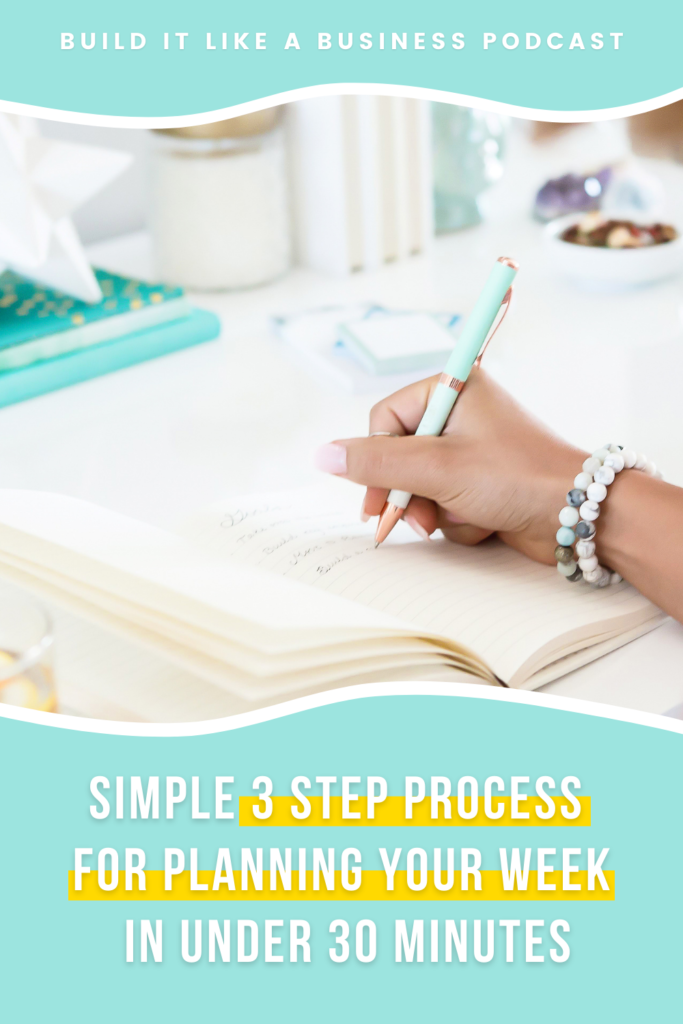
The Highlights:
Short & sweet episode highlights
The only two planners I’ve ever successfully used
Why they worked when other planners failed
The simple 3 step process I use to plan each week in 30 minutes
My very best tips for getting the most out of a planner
How to use a planner without wasting hours of time
The Links:
Links mentioned in this episode
Download Hot Leads on Tap
Check out the Simplified Planner by Emily Ley
Check out the Full Focus Planner by Michael Hyatt
Connect with Keleigh on Instagram
Follow Anchor Design Co. on Facebook
Join the Build it Like a Business Community
Get a FREE AnchorCard Digital Business Card
Get done-for-you social media content
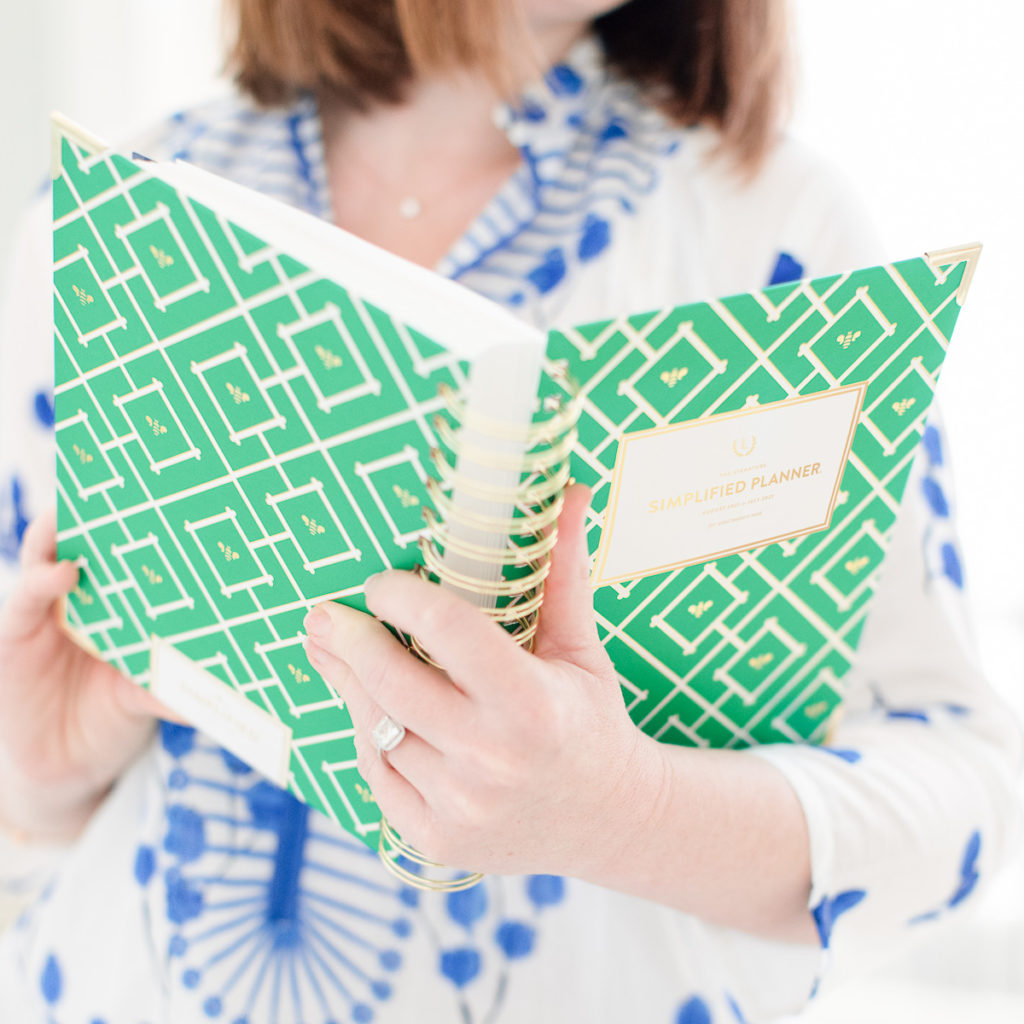
My Favorite Planners!
Check out my two favorite planners, the Simplified Planner by Emily Ley and the Full Focus Planner by Michael Hyatt!
Looking for support?
Search for an answer in our recent episodes!


